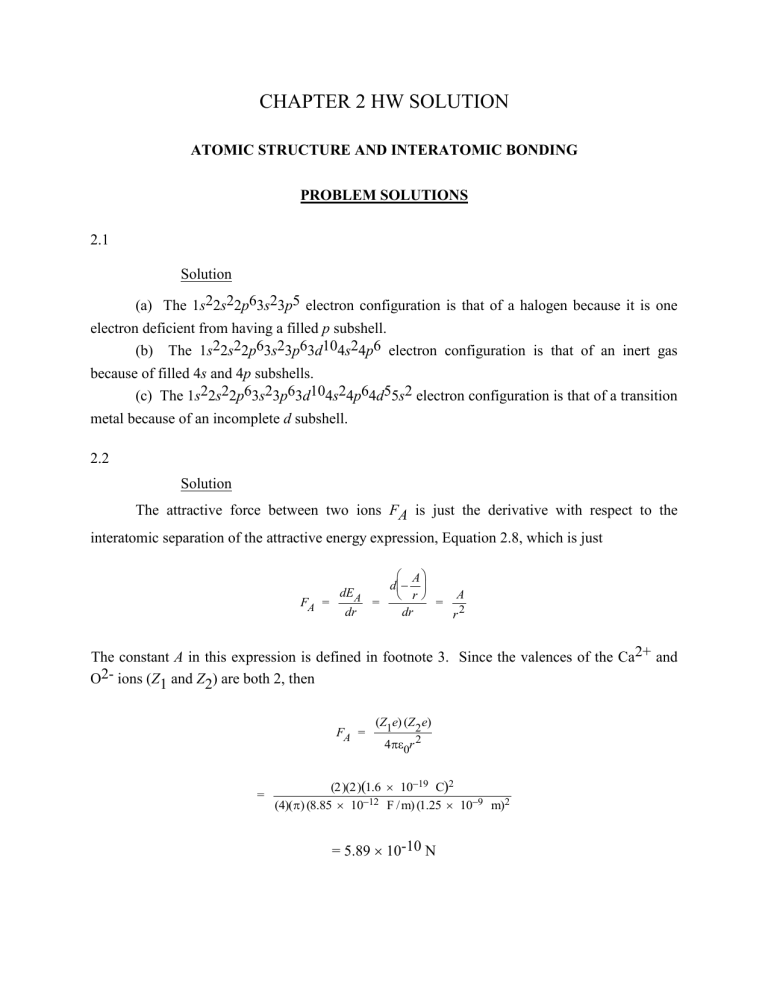
CHAPTER 2 HW SOLUTION ATOMIC STRUCTURE AND INTERATOMIC BONDING PROBLEM SOLUTIONS 2.1 Solution (a) The 1s22s22p63s23p5 electron configuration is that of a halogen because it is one electron deficient from having a filled p subshell. (b) The 1s22s22p63s23p63d104s24p6 electron configuration is that of an inert gas because of filled 4s and 4p subshells. (c) The 1s22s22p63s23p63d104s24p64d55s2 electron configuration is that of a transition metal because of an incomplete d subshell. 2.2 Solution The attractive force between two ions FA is just the derivative with respect to the interatomic separation of the attractive energy expression, Equation 2.8, which is just FA = dEA dr A d A r = = dr r2 The constant A in this expression is defined in footnote 3. Since the valences of the Ca2+ and O2- ions (Z1 and Z2) are both 2, then FA = = (Z1e) (Z 2 e) 40r 2 (2)(2)(1.6 1019 C)2 (8.85 1012 F / m) (1.25 109 m)2 (4)() = 5.89 10-10 N 2.3 Solution (1) Differentiation of Equation 2.11 yields dEN dr = B A d d r r n = dr dr A r (1 + 1) nB r (n + 1) = 0 (2) Now, solving for r (= r0) A r02 = nB r0(n + 1) A 1/(1 - n) r0 = nB (3) Substitution for r0 into Equation 2.11 and solving for E (= E0) E0 = A B + r0 r0n A B = + 1/(1 n) n/(1 A A - n) nB nB 2.4 Solution (a) The main differences between the various forms of primary bonding are: Ionic--there is electrostatic attraction between oppositely charged ions. Covalent--there is electron sharing between two adjacent atoms such that each atom assumes a stable electron configuration. Metallic--the positively charged ion cores are shielded from one another, and also "glued" together by the sea of valence electrons. (b) The Pauli exclusion principle states that each electron state can hold no more than two electrons, which must have opposite spins. 2.5 Solution For silicon, having the valence electron structure 3s23p2, N' = 4; thus, there are 8 – N' = 4 covalent bonds per atom. For nitrogen, having the valence electron structure 2s22p3, N' = 5; thus, there are 8 – N' = 3 covalent bonds per atom. For neon, having the valence electron structure 2s22p6, N’ = 8; thus, there are 8 – N' = 0 covalent bonds per atom, which is what we would expect since neon is an inert gas. 2.6 Solution The intermolecular bonding for HF is hydrogen, whereas for HCl, the intermolecular bonding is van der Waals. Since the hydrogen bond is stronger than van der Waals, HF will have a higher melting temperature.



